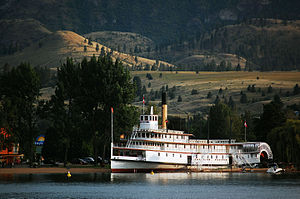Sicamous (sternwheeler)

SS Sicamous in Penticton
|
|
| History | |
|---|---|
|
|
|
| Owner: | S.S. Sicamous Restoration Society |
| Operator: | Canadian Pacific Railway |
| Port of registry: | Victoria, No. 134726:56 |
| Route: | Penticton to Okanagan Landing |
| Cost: | $180,000.00 |
| Launched: | 1914 |
| Maiden voyage: | May 19, 1914 |
| In service: | 1914-1937 |
| Out of service: | 1937 |
| Fate: | Docked and restored as a museum |
| Status: | Museum ship |
| General characteristics | |
| Type: | Sternwheeler |
| Tonnage: | 1787 tons |
| Length: | 200.5 ft (61.1 m) |
| Decks: | 5 |
SS Sicamous is a large five decked sternwheeler commissioned by the Canadian Pacific Railway (CPR) and built by the Western Dry Dock and Shipbuilding Company for Okanagan Lake service between the fruit communities of Penticton, and other towns of Kelowna and Vernon, British Columbia. Launched in 1914, Sicamous ran for many years connecting rail lines and areas. The vessel operated until 1937 and is currently beached as a part of a heritage shipyard operated by the S.S. Sicamous Restoration Society in Penticton. The vessel today is operated both as a museum and events and banquet facility.
Built in 1914, Sicamous made daily trips up and down Okanagan Lake until 1936, with her last official voyage in 1937. Throughout her twenty-two years of official service, Sicamous remained an important link within the transportation system of the Okanagan. Sicamous now resides in Penticton where she continues to undergo restoration. Sicamous had the following dimensions:
Although passengers would board the ship on the cargo deck, their access was limited to the bow. After boarding they would head up either one of the two exterior staircases leading to the saloon deck. The saloon deck was home to the exquisite dining hall featuring an impressive mezzanine balcony and clerestory windows. Located at the bow was the Gentlemen’s Saloon with bar, while the stern housed the Ladies Saloon complete with a beautiful bridal suite. Above the saloon deck was the observation deck or gallery deck. This was where passengers would go to admire the beautiful view of Okanagan Lake and the surrounding area. Much like the saloon deck, ladies and gentlemen each had their own separate observation area with women observing at the bow, and men at the stern. Just beneath the Pilot House was the Texas Deck. This area served as a casual meeting place for the captain and his crew.
The Kettle Valley Railway, which ran along the East side of Okanagan Lake, as well as the construction of the highway along the West side and also the Great Depression in the 1930s contributed to Sicamous losing money for the CPR. As a result, the CPR decided to renovate Sicamous, removing the Texas Deck and two thirds of the observation deck. These changes were designed to reduce wind resistance and weight, decreasing coal consumption and allowing for more cargo to be transported. Despite her decrease in size, Sicamous remained a first-class steamship with the same fine Australian mahogany and Burmese teak finishings.
...
Wikipedia
